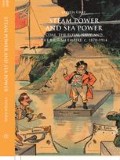Abstract
When the Royal Navy shifted from sail to steam power, it shackled itself to coal and coaling stations. As the primary defence of British interests and trade abroad, this meant that Britain now required a chain of fuelling stations across the globe that were amply supplied at all times with quality fuel. The importance of the navy to the British economy, as well as its global role, meant that this shift had ramifications that went far beyond warship s. Indeed, it required serious reconsiderations of imperial defence, naval infrastructure, and supply. Moreover, it required significant labour for coaling, a process accomplished largely by hand, necessitating that ships and their crews stopped more regularly at foreign stations. As such, sailors increasingly interacted with indigenous and settler populations.
Access this chapter
Tax calculation will be finalised at checkout
Purchases are for personal use only
Notes
- 1.
“Her Majesty’s Ship Devastation,” The Times, 13 July 1871.
- 2.
“The Devastation,” Inter Ocean (Chicago), 19 July 1874. The ship was also covered extensively in J.W. King, Report of Chief Engineer J.W. King, United States navy, on European ships of war and their armament, naval administration and economy, marine constructions and appliances, dockyards, etc, (Washington, DC: Government Printing Office, 1877).
- 3.
“Her Majesty’s Ship Devastation,” The Times, 13 July 1871.
- 4.
“The Devastation,” Inter Ocean (Chicago), 19 July 1874.
- 5.
Ibid.
- 6.
Asa Walker, “The Battle of Manila Bay,” Unpublished manuscript, Record Group 14, Naval War College Archives, Newport, R.I., 1900. Cited in John H. Maurer, “Fuel and the Battle Fleet: Coal, Oil, and American Naval Strategy, 1898–1925,” Naval War College Review, 34 (6), 60.
- 7.
Robert Seager and Doris D. Maguire (eds), Letters and Papers of Alfred Thayer Mahan, Vol. 3 (Annapolis: Naval Institute Press, 1975), 399.
- 8.
Daniel R. Headrick, The Tools of Empire: Technology and European Imperialism in the Nineteenth Century (Oxford: Oxford University Press, 1981), 4.
- 9.
John Darwin, The Empire Project (Cambridge: Cambridge University Press, 2009).
- 10.
Andrew Lambert, “The Shield of Empire 1815–1895,” in J.R. Hill (ed.), The Oxford Illustrated History of the Royal Navy (Oxford: Oxford University Press, 1995), 161–199.
- 11.
B. Freese, Coal: a human history, Oxford, 2003, 2, 13.
- 12.
Headrick, The Tools of Empire, 11–12.
- 13.
“King Coal,” Western Mail, 9 November 1898.
Author information
Authors and Affiliations
Corresponding author
Copyright information
© 2018 The Author(s)
About this chapter
Cite this chapter
Gray, S. (2018). Introduction. In: Steam Power and Sea Power. Cambridge Imperial and Post-Colonial Studies Series. Palgrave Macmillan, London. https://doi.org/10.1057/978-1-137-57642-2_1
Download citation
DOI: https://doi.org/10.1057/978-1-137-57642-2_1
Published:
Publisher Name: Palgrave Macmillan, London
Print ISBN: 978-1-137-57641-5
Online ISBN: 978-1-137-57642-2
eBook Packages: HistoryHistory (R0)

